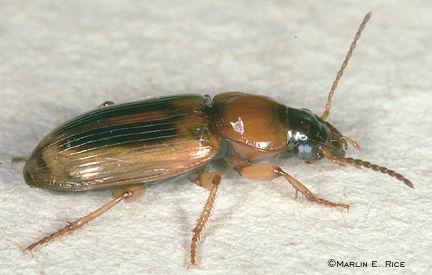Seed Corn Beetle and Seed Corn Maggot
Agonoderus lecontei and Delia platura.
|
Adult seed corn beetle. |
Seed corn maggot on germinating seed. |
Seed corn beetles are about 1/3-inch long and dark brown with a lightbrown to tan border stripe on the wing covers. Gaps in the crop stand may result from destruction of the seed germ (embryo) or completely hollowed seed. Some seedling plants may appear stunted due to beetles feeding on the mesocotyl.
The seed corn maggot is a slender, pale yellowish-white larva. Full-grown maggots are legless, about ¼-inch long, and tapered toward the front end. The adult resembles a slender, grayish housefly. Maggots damage seed so that germination fails and stand establishment in the field is reduced. Land that has been fertilized with manure or where a cover crop has recently been recently tilled under may be attractive to egg-laying adult flies.
Most of the soil insecticides employed for corn rootworm control will also provide protection against various seed-attacking insects. However, an insecticidal seed treatment may be beneficial when planting corn into fields with a recent history of sod, alfalfa, or reduced tillage, especially if cool, wet soils are present that are likely to delay germination. In most cases, risks of losses from these increase when planting occurs before June 2 in southeast Kansas, June 4 in south central Kansas, June 5 in northeast Kansas, June 7 in southwest Kansas, and June 12 in northwest Kansas. Be vigilant for large numbers of adult flies that are attracted to moist soil exposed when the ground is worked just prior to planting.
Please refer to the most recent version of the Corn Insect Management Guide for treatment options.
Page last updated 4/2/2024 by J.P. Michaud.
